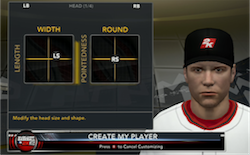MLB 2K12: Can I Get Some Animations in Player Creation?

In the last article, I talked about how the realistic use of animations in MLB 2K12 makes the game take way too long to play. While the animations are pretty, after you see them once or twice it’s easy to realize that they don’t offer the player any lasting benefit. This time, I’m here to tell you that in another case, the lack of animation causes a serious usability problem in MLB 2K12.
When creating a player, there are all kinds of things you can customize - the equipment they use, what color socks they wear, and all manner of things about your pro-to-be’s body shape. As I was building the San Diego Padres’ next superstar closer, I was excited to see the detailed controls for customizing the player’s face - there are two two-dimensional sliders that you control with both of your controller’s thumbsticks. That’s a serious control for some seriously detailed customization. But take a look at what happens when you’re adjusting these sliders:
That’s right, every time you move one of the sliders, your player disappears until you stop. And since the controls here make only very fine adjustments to the player’s face, it’s really hard to tell if anything changed at all. In fact, it wasn’t until I took some screenshots of the video on my computer that I could identify that this part of the game wasn’t actually broken.
Animation is a great way to let your users know what is changing. The player creator in MLB 2K12 is a perfect example of when a simple animation could be massive in showing the difference between two states. When I make adjustments like this one, I want to know the results in real-time.
Thankfully, there are lots of other examples of create-a-player interfaces that get it right. Mass Effect 3’s “Commander Shepard creator” doesn’t offer quite the fine-grained control as MLB 2K12 - it uses a slider that only has a handful of different stops for different face types (aside: this might be an example of a poorly chosen control, because why would you use a slider here?) Check it out:
It’s not perfect, but with Mass Effect 3’s face customization feature it’s way easier to tell what is changing. Although to be fair, the changes in face shape are considerably more pronounced when there are only a few to choose from. A better comparison might be found in the following clip of EA’s Tiger Woods 2008 game (heads up I’m starting you in the middle of an EA-produced promo video for the game):
The Tiger Woods series has always had some of the best player customization features, and this is a great example of how to do it right. Showing the face morph as the sliders are modified is a huge help. It makes face customization more of a “let me tweak this to get it perfect” and less of the guess-and-check “eh I’ll set it here and see what happens - nope, let me try again…”.
Finally, I’ll close with thatgamesux’s Golden Rule of Animation in User Interfaces (patent pending):
Animate things when you want to show the user how point A became point B. If the user notices the animation is happening, you’re not doing it fast enough.